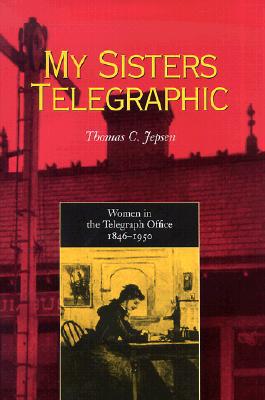

 |

|

Sold Out
Book Categories |
In 1870s England, male and female telegraph operators generally worked together. It was a positive arrangement, the postmaster general believed, because "it raises the tone of the male staff by confining them during many hours of the day to a decency of conversation and demeanor which is not always to be found where men alone are employed."
It wasn't a belief similarly held in the states, however. The author provides nuggets such as this in his treatment on the history of women and their overlooked role in the early industry of telegraphy here and abroad.
The book's title comes from a letter published in the January, 1865, issue of Telegrapher, a publication of the National Telegraphic Union (NTU), the earliest U.S. organization founded to promote the interests of telegraphic workers.
A female worker called attention to a previous male letter-writer's statement that women shouldn't be admitted to the NTU. She called on her fellow female operators--"my sisters telegraphic"--to resist these gender inequities.
There were a few--which are a reoccurring theme that Jepsen, the author of several previous articles on the history of telecommunications--touches on. Working for half the pay as male counterparts and being forced to retire upon marrying are but two examples. While there were some negative aspects, the book suggests the advent of females in the telegraphic industry actually opened up an entirely new "sphere" for the nineteenth century working woman, offering a good wage and opportunities that weren't readily available to most women.
Writing in a chronological fashion, the author traces this history. He makes it personal and real by his use of authentic examples: "Ma" Kiley, who worked in and around the American southwest; the Mormon families who assisted with the Deseret Telegraph in Utah; and Hettie Ogle, manager of the Johnstown Pennsylvania Western Union Office, who died in the infamous 1889 flood.
Perhaps the most interesting chapter is the one concerned with the portrayal of woman telegraphers in the literature and cinema of the day. Jepsen tells of an entirely new literary genre--the "telegraphic romance"--which evolved. "Wooing by Wire" and "Wired Love" were the titles of two such popular works.
Jepsen concludes that male operators at the time "were sometimes surprised to learn that the first-class 'man' at the other end of the line was, in fact, a woman."
Female telegraphers tended to be young, single, highly literate, native-born women who were attracted to the relatively clean working environment and the opportunity of upward social mobility. This exploration of women in telegraphy expands on Edwin Gabler's The American Telegrapher: A Social History, 1860-1900 (1988) by several decades and focuses more narrowly on women, who accounted for over 20 percent of telegraphers in the 1880s. Women usually left telegraphy after marriage, but Jepsen, a telecommunications systems engineer, offers a creative chapter on the "telegraphic romance," a minor literary genre and cinematic theme. Women telegraphers also participated in the labor movement, and although several strikes by telegraphers were unsuccessful, women gained leadership experience and made alliances with the women's movement. This valuable history of women's employment in a technological profession is appropriate for women's studies or labor history collections in academic or large public libraries.--Patricia A. Beaber, Coll. of New Jersey Lib., Ewing Copyright 2000 Cahners Business Information.
Login|Complaints|Blog|Games|Digital Media|Souls|Obituary|Contact Us|FAQ
CAN'T FIND WHAT YOU'RE LOOKING FOR? CLICK HERE!!! X
 You must be logged in to add to WishlistX
 This item is in your Wish ListX
 This item is in your CollectionMy Sisters Telegraphic: Women in the Telegraph Office, 1846-1950
X
 This Item is in Your InventoryMy Sisters Telegraphic: Women in the Telegraph Office, 1846-1950
X
 You must be logged in to review the productsX
 X
 X

Add My Sisters Telegraphic: Women in the Telegraph Office, 1846-1950, , My Sisters Telegraphic: Women in the Telegraph Office, 1846-1950 to the inventory that you are selling on WonderClubX
 X

Add My Sisters Telegraphic: Women in the Telegraph Office, 1846-1950, , My Sisters Telegraphic: Women in the Telegraph Office, 1846-1950 to your collection on WonderClub |